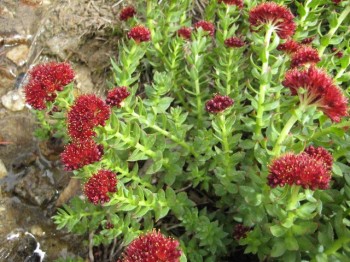
I first noticed roseroot on a high-country hike above Fairplay, Colorado as Gregg and I were scrambling up a rock face, off-trail as usual. The plant is distinctive and attractive—tiny, blood-red flowers atop a fleshy stalk with spirally overlapping (Peterson, 1977) succulent, white-green leaves—and so I photographed it to look up later in Plants of the Rocky Mountains, a flora identification guide we obtained recently from The Printed Page bookshop in Denver.
Plants of the Rocky Mountains by Linda Kershaw, et. al. (1998) is not specific to edible wild plants, but when I found the plant in question in the picture index followed by the entry, lo and behold, I also discovered that our local roseroot is edible. (A quick perusal of the new guide revealed that edibility information is included for many of the plants, to my very pleasant surprise. Come to find out that Linda Kershaw also authored Edible and Medicinal Plants of the Rockies, a guide I have yet to obtain.) What luck!
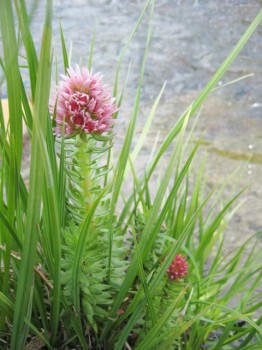
The only thing that confused me was the part in Plants of the Rocky Mountains that says roseroot is related to rosecrown, a taller plant that grows in wet places like streams. Although I first found what I thought was roseroot on a dry rocky slope (as predicted by Plants of the Rocky Mountains), I also found what I thought was the same plant growing on the wet banks of a stream. Plus, Kershaw, et. al. never say that rosecrown is edible, so I remained with some doubts.
Roseroot Versus Rosecrown
I found the answers I sought in Peterson’s Field Guide to Rocky Mountain Wildflowers: Northern Arizona and New Mexico (1998), which explains that not only do roseroot and rosecrown often grow in proximity to one another, but also that they are both edible (if I understood correctly). The two are in the Orpine family, genus Sedum. Roseroot—with nicknames including include King’s Crown and Western Roseroot—is S. rosea (also referred to as S. integrifolium, according to Kershaw et. al.) It has flat flower heads with dark, narrow petals on each flower. Rosecrown is S. rhodanthum, which has rose-colored flower heads with lanceolate petals that “superficially resemble red clover,” as the authors put it.
I’m fairly certain the streamside plant I found at 11,400 feet was S. rosea. Whether rosea or rhodanthum, however, I at least felt comfortable trying the plant, if only in small quantities at first.
Initial Edibility Test
Following the instructions of Kershaw, et. al., Gregg and I aimed for the young leaves and shoots, which they say are high in Vitamins A and C and can be eaten raw or cooked. So, even though we first identified the plant by its tiny red flowers, for our first taste we picked a younger shoot nearby that had not yet flowered. I cut the fleshy, succulent stem in half and split it with Gregg; we both ate stem, leaves, and all. The taste was mild but we were both pleased with the substantial texture of the plant, thinking that it might make a hearty vegetable once we figure out how to prepare it. We waited a day and felt no ill effects, so it was on to the next step.
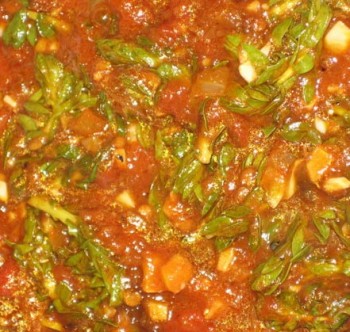
Roseroot Salsa
Kershaw, et. al. say that “a touch of garlic enhances the flavour, and [roseroot is] good alone or stewed with fresh tomatoes and a little thyme, dill, salt, and pepper.” Lacking tomatoes on the night of the first kitchen trial, I opted to fry about 10 or so roseroot shoots in olive oil with a mixture of two leftover salsas—some pico de gallo from a jar plus a few spoonfuls of Herdez salsa ranchera—to serve atop tostadas with corn, pinto beans, and curly dock.
Sampling the modified salsa while cooking, I was surprised to find that the roseroot had a strong flavor that almost overtook the salsa. (This is in contrast to my initial assessment of the plant as “mild.”) So I added more and more salsa ranchera to tone down the taste. I must have done a good job with that because Gregg said he couldn’t even taste the roseroot. I have to admit the texture came out a little strange with the frying.
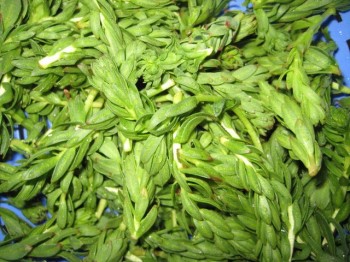
Sweet Pickled Roseroot
There isn’t much to say on this preparation attempt, except that I like to experiment with adding various succulent wild edibles to the icebox sweet pickle recipe my grandmother gave me. I’ve tried it with stonecrop flowers and purslane stems and leaves. The roseroot worked well too, although I still find the flavor a bit strong. I made the pickles with bite-size pieces of roseroot, stonecrop flowers, and cucumbers but then found that I preferred the taste and consistency after chopping them up fine like a relish.
Raw Roseroot in Salad
The raw roseroot was pretty good in a wild salad I made for Gregg and his sisters, along with (commercial) spinach and snow peas, dandelion leaves, and bluebell leaves and flowers. It’s attractive and unique in appearance, so it enhanced the salad nicely.
Roseroot as Medicine?
A search of roseroot on WebMD revealed a wide range of healing properties attributed to Rhodiola rosea, which has been (and presumably still is) eaten by the Eskimos of Alaska and Greenland (Medicinal and Aromatic Plants, 2006). Notice that I am talking about a different scientific name now. Rhodiola rosea is called by the common name “roseroot” as is Sedum rosea, about which I wrote above. So what is the difference?
I had a difficult time finding the answer to that question. Some sources seem to imply they are the same plant, but R. rosea pictures show yellow flowers compared to S. rosea’s red flowers. According to a team of doctors at psychoactiveherbs.com, there are some taxonomic ambiguities with Rhodiolas and Sedums owing to ongoing reclassifications over the last century. At this point, I’m thinking they’re different but related plants.
Too bad. Rhodiola rosea is an adaptogen—which means that it is useful in helping the body adjust to and/or resist a variety of environmental, physical, and chemical stresses. According to WebMD, it has also been used to increase energy, stamina, and mental capacity; to improve sex; to alleviate depression; and to treat heart disorders and high cholesterol. The active (and much sought after) ingredients are the rosavins it contains. It would have been quite a boon to discover that S. rosea was imbued with similar healing qualities, but I don’t think that’s the case.
According Bertalan Galambosi’s chapter in Medicinal and Aromatic Plants [PDF], native populations of R. rosea are over-collected in Siberia, making it a threatened species there. A search of my local plant, S. rosea, on the U.S. Endangered Species website, however, revealed no listings.
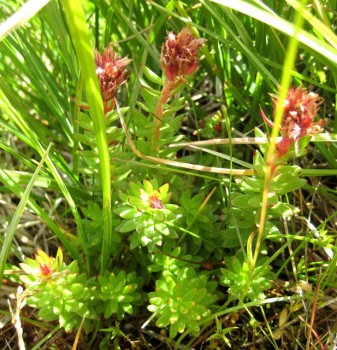
Soy Sauce and Onions Work Every Time
Ok, so the new wild edible in my refrigerator may or may not have healing properties, but it is still tasty, much more so with my most recent preparation attempt. I blanched the young shoots in boiling water for four minutes and then fried them lightly with finely chopped onions and soy sauce. Gregg was enthralled. “I think the roseroot was by far the best dish on the plate tonight,” he said, which is saying something, because I went all out on dinner that night.
There’s just one thing. I’m starting to think that what I served this last time was rosecrown and not roseroot, seeing as the flowers were pinkish instead of bright red and the flowerheads were clover-shaped versus flat-topped. So there’s always the chance that Gregg simply prefers rosecrown over roseroot.
Regardless, there is one thing I can say with certainty. When it comes to preparing and eating wild edible plants, soy sauce and finely chopped onions are the way to go!

Thanks for the wonderful article and photos. I was just researching a little about Rhodiola and came across your article. Now seeing your photos, especially the last one of young rosecrown roots, now I wonder if that is the same plant my dad transplanted from a relatively high altitude up toward Mt. Rainier. I would be interested in knowing where you took that photo. It resembles our plant much more closely than kingscrown, which I found photos of which were taken near Mt. Rainier.
I took Rhodiola supplements a few years back before embarking on a trip in western China, in Qinghai province, flying into Xining, which is pretty high. I didn’t get altitude sickness but a colleague of mine did, and she hadn’t taken any supplements, not to say that proves anything one way or the other.
Again thanks for the information. It looks great and I hope to try some one day too.